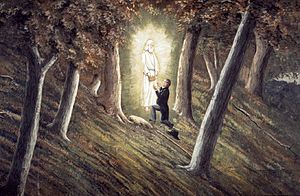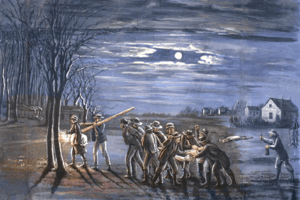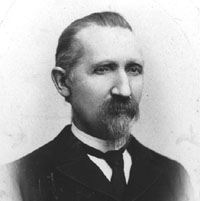C. C. A. Christensen facts for kids


Carl Christian Anton Christensen (born November 28, 1831 – died July 3, 1912) was a Danish-American artist. He is famous for his paintings. These paintings show the history of The Church of Jesus Christ of Latter-day Saints (LDS Church). People say he helped capture the story of Mormon migration to Utah more than anyone else.
Contents
Early Life and Missions
Christensen was born in Copenhagen, Denmark. He studied art at the Royal Danish Academy of Fine Arts. On September 26, 1850, he joined the LDS Church. He then served as a missionary in Denmark.
In 1853, Christensen became a missionary in Norway. He was the first Mormon missionary to preach in Christiania (now Oslo). There, he taught Danquart Anthon Weggeland. Danquart also became a famous artist in Utah. Christensen was put in prison twice in Norway. This happened because officials did not like him preaching Mormonism.
In 1857, Christensen finished his mission. He then traveled to Utah Territory. He stopped in England first. He married Elsie Scheel Haarby in Liverpool, England. They had met while he was serving in Norway. They sailed to America on the Westmoreland. After reaching New York City, they took a train to Iowa City, Iowa. From there, they walked to Utah. They traveled with the Christian Christiansen handcart company.
Painting and Artworks
When Christensen first arrived in Utah, it was hard to find art jobs. He worked as a housepainter and did other odd jobs. In 1862, he painted scenery for a theater in Springville, Utah.
One of his first big art projects was for Dimick B. Huntington. Christensen worked with Dan Weggeland on this. They painted scenes from the Bible and the Book of Mormon.
Christensen is best known for his Mormon Panorama. This is a series of 23 large paintings. They show the history of the LDS Church. He also painted scenes from the Book of Mormon. An example is Nephi and Zoram Return with the Record. His Book of Mormon paintings were first used in Sunday School classes. Later, they were made into prints.
In 1878, Christensen began traveling with his panorama. It was about 175 feet (53 meters) long. He took it around Utah, Idaho, and Wyoming. He would give presentations with the panorama. He did this during the winter when he was not busy farming. After Christensen died, the panorama was stored away. Years later, it was found again. Boyd K. Packer helped bring it back to public view. It became very famous when it was shown at the Whitney Museum of American Art in New York City.
Christensen also painted murals in the Manti and St. George Temples. He also created paintings for the Manti Tabernacle. Some of his paintings showed Manti and the areas around it. Christensen often worked with Dan Weggeland on his art projects in Utah.
Other Activities in Utah
During his early days in Utah, Christensen did not have much time for painting. He did many different jobs. These included laying bricks, burning charcoal, and farming.
Christensen wrote many LDS hymns in Danish. Some of his translated hymns are still used today. He also wrote poetry. He contributed to a publication called Bikuben. Later, he became an editor for that paper. He also helped write the History of the Scandinavian Mission.
Christensen taught drawing and Danish at the Sanpete Stake Academy. This school is now called Snow College.
He served a second mission from 1865 to 1868. He went on a third mission to Denmark from 1887 to 1889. During this mission, he edited the Scandinaviens Stjerne newspaper.
In 1901, Christensen became the patriarch for the Sanpete Stake. He also worked at the LDS Church Historian's Office. There, he gathered information about the church's history in Scandinavia.
Rediscovery of His Work
In 1976, Boyd K. Packer gave a speech at Brigham Young University. He was an apostle in the LDS Church. He talked about how Christensen's art was found again:
Some years ago I was chairman of a committee of seminary men responsible to produce a filmstrip on Church history. One of the group, Trevor Christensen, remembered that down in Sanpete County was a large canvas roll of paintings. They had been painted by one of his progenitors, C. C. A. Christensen, who traveled through the settlements giving a lecture on Church history as each painting was unrolled and displayed by lamplight. The roll of paintings had been stored away for generations. We sent a truck for them, and I shall not forget the day we unrolled it.
Christensen's 1900 painting called Handcart Pioneers is very famous. It is not part of the Mormon Panorama. This painting has been published more than any other painting about the Mormon pioneer experience by an actual pioneer.


